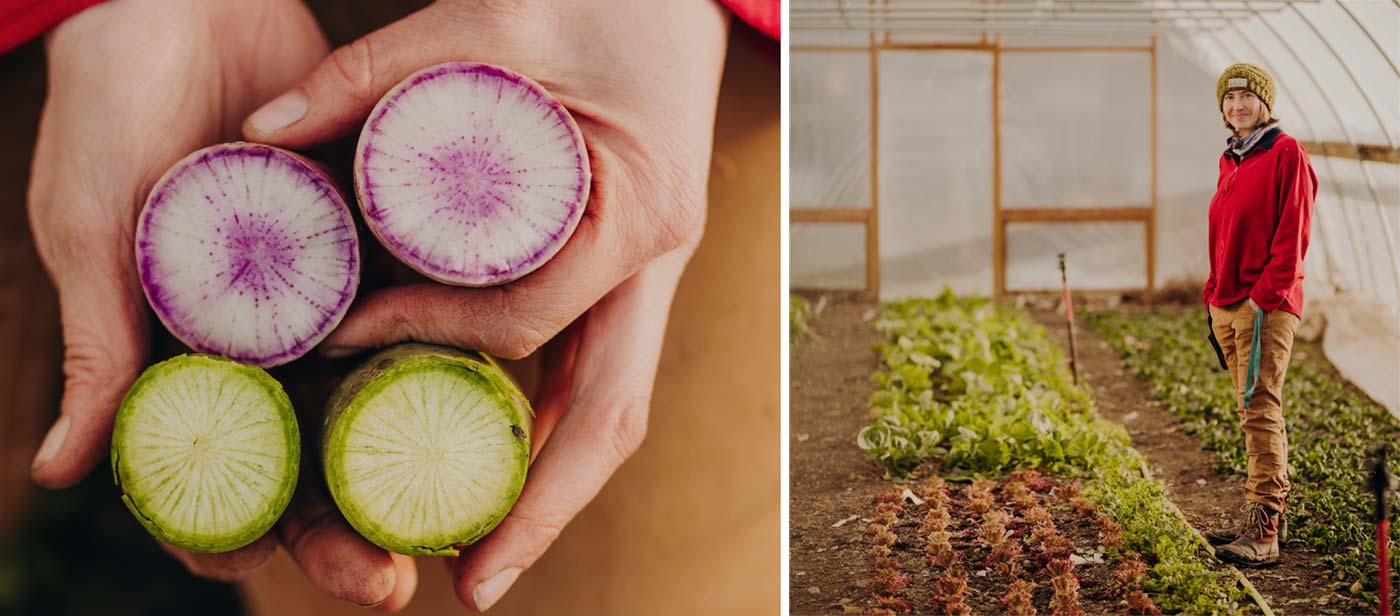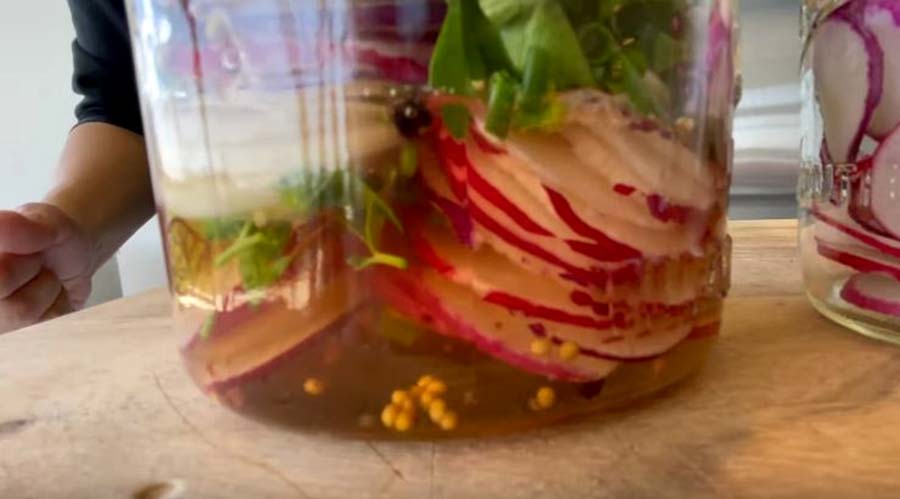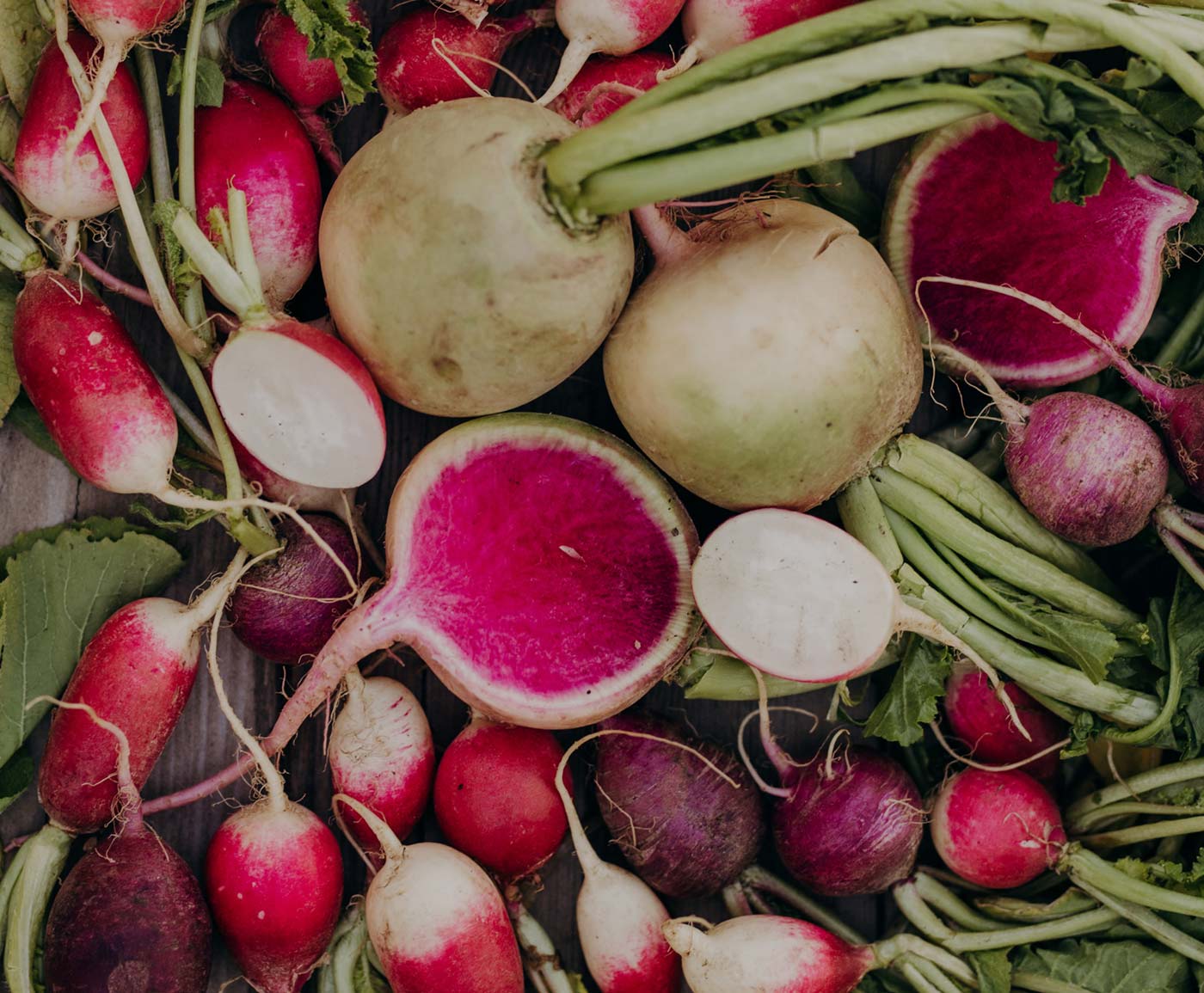Respect for the Radish
In the diverse troupe of garden vegetables, the humble radish has never been the star. Too often typecast as a mere garnish, the radish rarely received a credit in most classic cookbooks—where the index typically jumps from “radicchio” straight to “raisins.”
But there are good reasons the radish has stuck around for thousands of years. It delivers a peppery bite unlike other root vegetables. It’s easy to grow, takes up little space in a garden and requires minimal maintenance. It comes in a variety of colors and shapes and sizes—and the entire plant is edible. It also provides a good combination of nutrients and dietary fiber.
“Radishes are super versatile,” says Michelle Nowak, farm manager at Franklinton Farms. “They can be eaten raw, of course, but they can also be pickled or roasted or grilled or used in soups. They also have a very long growing season.”
Radishes are often the first fresh vegetable to make an appearance in spring, because the seeds can be planted early and will deliver mature radishes in a little as three weeks. They are a member of the brassica family, which includes turnips, broccoli and cabbage.
Radishes are low in calories and carbohydrates, but they are an excellent source of fiber. For their small size, they also deliver a good dose of potassium, which can help lower blood pressure, as well as immune-boosting vitamin C and other antioxidants.

(left) Michelle Nowak displays an enormous Daikon radish harvested in in mid-winter. (right) Radishes can be grown from seed in as little as three weeks.

One of the high tunnels used by Franklinton Farms to extend the growing season
When you eat a radish, you are sharing an experience with Spanish conquistadors, ancient Greeks and even the workers who built the pyramids in Egypt, according to historical accounts. It is generally believed that radishes originated in Asia and spread west through trade. Today they are grown around the world and in almost every U.S. state. Ohio is actually one of the top five states in radish production.
At Franklinton Farms, Nowak grows at least six varieties of radishes as part of the vegetable and fruit crops that will be distributed to West Side neighbors, included in CSA packages and sold at the Worthington Farmers Market. Launched as a community garden, the nonprofit urban farm operation has grown to include dozens of disconnected neighborhood sites. With a goal of providing healthy food options to the community, the farm includes 12 high tunnels to extend the growing season and a learning garden at West Town Street and Hawkes Avenue that hosts education programs for neighbors and their kids.
Radish season begins with Nowak ordering seeds for about half a dozen varieties from among the dozens of types available in seed catalogs. The spring plantings will include the round red radishes that everyone recognizes, as well as the Easter Egg variety that produces a mix of red, purple, pink and white round radishes. She also grows the French Breakfast radish, an oblong type with a white tip, considered a bit milder and sweeter than other types. As the name indicates, this variety originated in France in the late 1800s. The classic way to serve them is by placing slices on a buttered baguette along with a sprinkling of salt.
As nice as it is to see radishes popping up in the spring, Nowak says that her favorite varieties are the winter radishes, also called storage radishes. Planted in the fall, these slower-growing varieties take six weeks or more to mature, but they can be harvested even after the temperatures drop below freezing. In the high tunnels used at Franklinton Farms, they were still pulling radishes out of the ground during a January visit. “Cold weather really brings out the sweetness in these radishes,” Nowak says. “After they are harvested, you just cut the tops off and you can store them for months in the refrigerator.”
For the most recent late-season planting, Nowak settled on three varieties whose appearances are very different from the spring radishes. The Watermelon radish is probably the most familiar, with a name derived from its appearance: pale green to white exterior with a vivid pink-purple inside. The Green Luobo, which originated in China, resembles a small cucumber with bright green skin and interior. She also plants a purple Daikon variety called KN-Bravo, which has dramatic purple streaks through the white flesh. “We find that people like the novelty of the different colors and shapes, and also the range of flavors from spicier to sweeter,” she says.
Dr. Timothy McDermott, an educator with Ohio State University Extension, also is a fan of radishes, especially the Watermelon, Easter Egg and Purple Plum varieties. “Radishes are an excellent choice for the beginner to seasoned gardener and do very well here in Central Ohio,” he says. “They can be planted in traditional gardens, raised beds or even in containers.”
McDermott advises planting your radishes early in the spring or early in the fall so that they mature in cooler weather. In Central Ohio, the first planting can be done as early as mid-March, weather permitting, and you can plant a short row or patch every two weeks until mid to late May to get a constant harvest. He suggests planting again around Labor Day, then every two weeks until around Nov.1 for fall harvesting.
If your soil is classic Central Ohio heavy clay, he says, you should amend it with compost prior to planting so that the roots can achieve a good size prior to harvest. You want to lightly fertilize but not overfertilize, especially with nitrogen, or you will have more leaves than radishes.
“A key part of growing radishes is to thin them to a three-inch spacing shortly after they germinate,” McDermott says. “If they are crowded, they will not get to the right size. Radishes prefer full sun as well.”
Adding radishes to your diet is becoming easier as chefs around the country explore interesting ways to prepare them. You can start with the raw vegetable by adding thinly sliced radishes to a salad or slaw, or eating them with melted butter or your favorite dip. But here are other suggestions:

(left) A look at the purple Daikon variety called KN-Bravo and the Green Luobo; (right) Michelle Nowak with plants inside a high tunnel

OSU Extension has a YouTube video about making spicy radish pickles.
Pickled—McDermott and colleague Jenny Lobb have posted a YouTube video about making spicy radish pickles using an apple cider vinegar brine.
Roasted—Nowak likes to roast her root vegetables and offers this advice: Just slice thinly, spread out on a sheet pan, drizzle with olive oil, salt, pepper and fresh herbs, and roast at 350–450ºF until tender when pierced with a fork.
Grilled—North Carolina chef Katie Button recommends that you cut your radishes in half, leave the green tops attached, toss them in a little olive oil and salt and grill them. The leaves get crispy and the radish gets tender but still has a bite to it. Serve with a whipped butter.
Grated—The Mid-Ohio Kitchen suggests using grated radishes as a healthy substitution for potatoes in hash brown patties. You can find a variety of recipes online for radish hash browns.
Braised—Faith Durand, the Columbus-based editor in chief of popular food website TheKitchn.com, offers up a recipe for Braised Radishes with Shallots and Bacon at her site, where you can find a variety of other radish recipes.
Sautéed in a wok—This is the method preferred by Boston chef Joanne Chang, because the radishes take on some sweetness as they are caramelized.
You can also take the very simple approach described by pioneer culinary expert James Beard in one of his syndicated newspaper columns almost 50 years ago. Here is what he had to say in a column published by The Columbus Dispatch on Feb. 18, 1973:
“From my earliest years I have adored the crispness, colorfulness, and spicy tang of radishes. I can recall my first feeble efforts at gardening, when I planted little rows of radishes and was so thrilled when they came up, and even more thrilled when it was time to pull them and eat them fresh from the ground. Very few things in life have ever tasted better to me.”
To learn more about the Franklinton Farms operation and mission, visit franklintonfarms.org or follow them on Facebook and Instagram.





